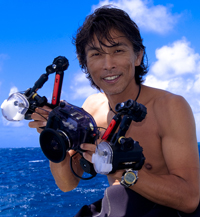Alizée (New Caledonia)
ASASHI OGAWA
Born in 1969 in Kyoto, Japan.
Currently working on public relations activities to make honeymooner New Caledonia a diver's destination. He likes to take photographs of fish and coral in the ocean, and liberal landscapes and plants by the waves on land. She is a member of the Guide Association.
Review of YS-01
Using the YS-01
The YS-01 is a new compact strobe from SEA&SEA, and when I took it out of the box and held it in my hand, my first impression was, "It's so small!"
I felt it was less than half the size of the YS-110α that I have been using for a long time.
The good thing about SEA&SEA strobes is the same for all of them: "Easy to use! Never miss a shutter chance! The SEA&SEA strobes are easy to use.
The mode switch and light level control dial are the only two controls I need. The target light switch is used only occasionally as needed.
When I am shooting underwater, I think that while I am messing around with detailed operations, the subject disappears from sight or hides in a burrow. I think one of the most important points of good photographic equipment is equipment that is easy to operate and requires only a minimal amount of manipulation.
Lightweight and compact.
Many people do not want to use a large strobe in their set-up because they are using a small camera.
The YS-01 fulfills this wish of underwater photography enthusiasts. I have never been a big believer in TTL for digital cameras.
But my favorite combination of the DX-2G and the YS-01, the DS-TTL, was perfect.
I tried it with a slightly open aperture to see if it would work, and it adjusted the amount of light with no problem. I first tried it with macro .
Next I tried the wide angle.
It was probably due to the quality of the subject's scales. The reflection was too strong and the image was a little too white.
I found the same condition when I moved a little closer to the subject, as evidence that it was not the distance between the subject and the camera.
This is where the DS-TTL minus correction function comes into play. Turn the light level control dial slightly to adjust the flash amount to your liking. If you know in advance whether a subject tends to glow easily or not, you can turn the dial to the minus side a little before taking a test shot.
A slight disappointment occurred when I tried shooting from an oblique angle. Perhaps it was because I corrected the image too much in the negative, but not much light reached the fish on the far left.
But don't worry. It is possible to use two strobes, with the right strobe set to DS-TTL with negative compensation and the left strobe firing in manual mode.
The result is a photo with little depth of field because the light is evenly distributed throughout the image, but it shows how multiple strobes can be used in different ways.
Tested again with an immobile strobe to take a closer look at the strobe's performance. This is a sea anemone found in the sand. Taken with two YS-01 strobes. Both strobes were set to DS-TTL with no correction. Perfect, no problem.
Next, I slightly turned both lights to minus in this photo. This is the photographer's intention and preference.
To take the lighting one step further, I used DS-TTL for both lights, but with a slight minus correction on the right side and even more minus on the left. I changed the amount of light on the right side and the left side. The shadows were clearly defined and the anemone had a three-dimensional effect thanks to the unevenness of the light.
The YS-01 is "easy to operate," "lightweight and compact," and "responsive to the photographer's intentions. The YS-01 offers a full range of reliable functions in a small body, and I look forward to using it to its fullest in the future.
*Copyright of these image data belongs to SEA&SEA Corporation or the photographer indicated.

